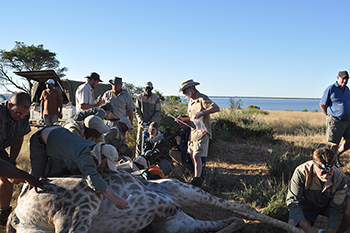
Dr Francois Deacon and Prof Fred Bercovitch
busy with field work. |
Researcher Dr Francois Deacon from the Department of Animal, Wildlife, and Grassland Sciences at the University of the Free State is conducting research with renowned wildlife scientist, Prof Fred Bercovitch, from the Center for International Collaboration and Advanced Studies in Primatology, Kyoto University Primate Research Institute in Japan.
Dr Deacon’s ground-breaking research has attracted international media attention. Together with Prof Nico Smit, he equipped giraffes with GPS collars, and conducted research based on this initiative. “Satellite tracking is proving to be extremely valuable in the wildlife environment. The unit is based on a mobile global two-way communication platform, utilising two-way data satellite communication, complete with GPS systems.”
Prof Bercovitch was involved with GPS tracking from elephants to koala bears.
Some of the highlights of the joint research on giraffes by Dr Deacon and Prof Bercovitch focus on:
• How much time do certain giraffes spend with, and away from, one another
• How do the home ranges of herds and individual giraffe overlap
• Do genetically-related animals spend more time together than non-genetically-related animals
• How much time do the young bulls, adult bulls, and dominant bulls spend with cow herds
• Herd interactions and social behaviours of giraffe
• The role of the veld and diet on animal behaviour and distribution
Their research article, “Gazing at a giraffe gyroscope: Where are we going?”, which was published in the African Journal of Ecology, assesses recent research by exploring five primary questions:
- How many (sub) species of giraffe exist?
- What are the dynamics of giraffe herds?
- How do giraffe communicate?
- What is the role of sexual selection in giraffe reproduction?
- How many giraffe reside in Africa?
They conclude this article by emphasising that the most essential issue is to develop conservation management plans that will save a wonderful species from extinction, and which will also enable scientists to conduct additional research aimed at answering their five questions.
In addition, they are working together on a grand proposal to get National Geographic to cover their work.